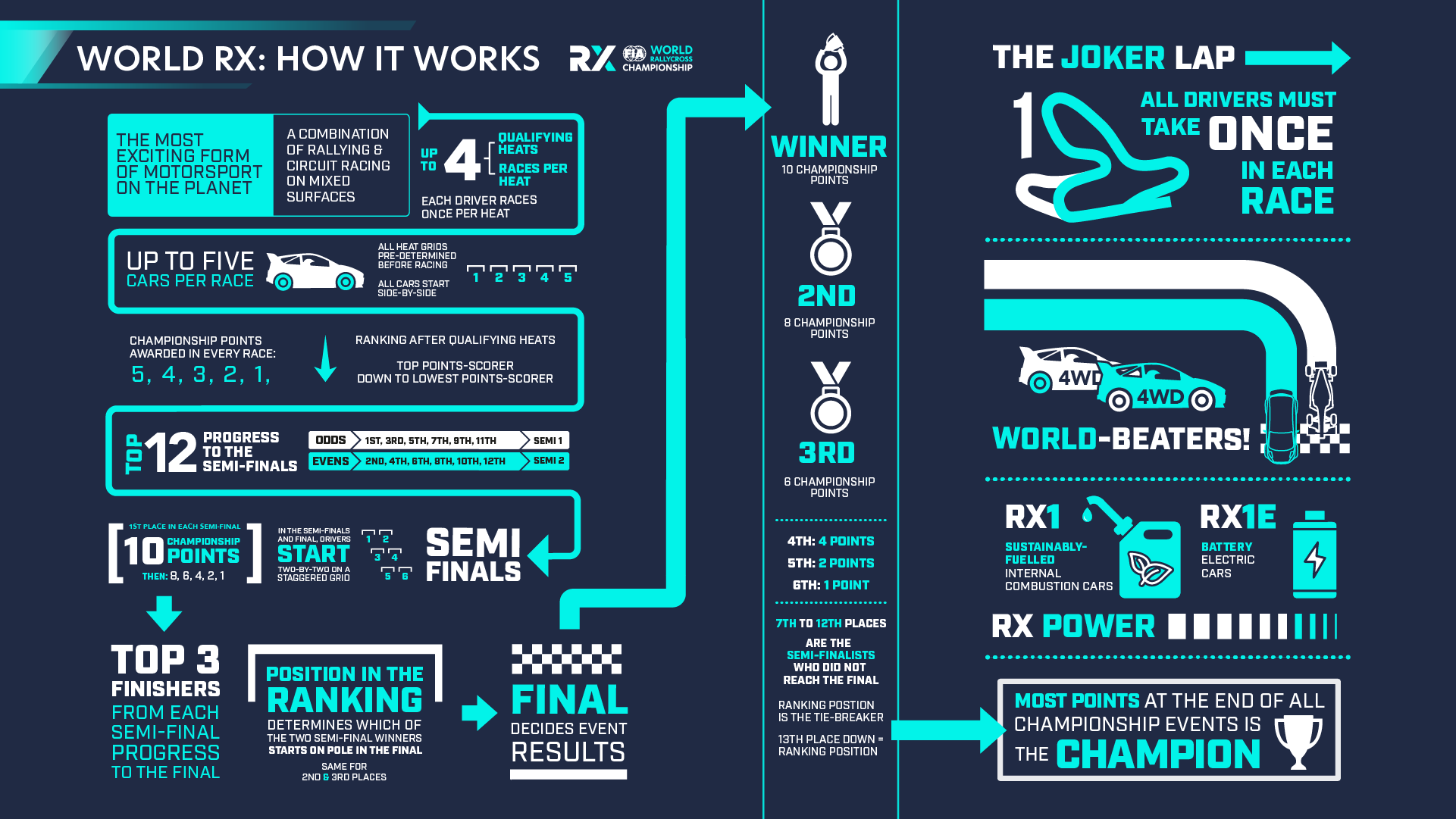Introduction
Rallycross combines the very best elements of rallying and circuit racing, with a
history stretching back more than half-a-century. Blending cutting-edge
innovation with family-friendly spectator appeal, the FIA World Rallycross
Championship (World RX) showcases head-to-head racing on mixed surfaces (gravel and asphalt) within
amphitheatre-like venues.
An evolution of the popular and prestigious
FIA European Rallycross Championship – which traces its roots back to 1973 –
World RX was launched in 2014 and represents the international pinnacle of the
discipline, visiting some of the most iconic venues in the sport where high-profile
drivers duel wheel-to-wheel in cars capable of catapulting from 0-100km/h
faster than Formula 1.
No-holds-barred
contests between motorsport’s modern-day gladiators. Breathless races
delivering breathtaking action. Non-stop thrills from the moment the lights go
out to the moment the chequered flag falls. A platform for developing and
showcasing ground-breaking technologies. This is World RX.
In evidence
of its commitment to cutting-edge innovation, the series entered a new era in 2022 by
embracing electric technology, while 2024 heralded the beginning of the ‘Battle
of Technologies’, seeing the series’ powerful EV cars take on their
sustainably-fuelled combustion counterparts on equal terms for the first time.
Short,
sharp racing and intense duels are inherent in rallycross’ DNA, and the
headlining World RX show-stoppers are supported at different events by the all-electric
FIA RX2e Championship and combustion Euro RX1 and Euro RX3 categories, ensuring
a full package of exhilarating entertainment.
Racing
Format
Each
race weekend begins with free practice sessions, to allow competitors to settle
into the groove, refine their set-ups and get to grips with the track if it is
new to them.
Next
up are the heat races, with pre-determined starting positions as up to five competitors
line up side-by-side on the same row of the grid. What this means is that – in
the instance of a 16-car field – every driver competes in the first race of a
heat once, the second race of a heat once, the third race of a heat once and
the fourth race of a heat once. They also start one race from pole position,
one race from second on the grid, one race from third on the grid and one race
from fourth on the grid. This is adapted accordingly for races featuring more
or less than four cars, and double-header events comprise fewer heats.
Competitors
race for position rather than against the clock. Championship points are
awarded in all heat races, from five for the winner down to a single point for
fifth place. Non-finishers receive one point, while non-starters do not score.
Failure to take the joker lap results in a one-point deduction, with
disqualification penalised by the loss of at least two championship
points.
The
points scored during the heats form the basis for the Ranking, with tie-breaks
resolved in favour of the driver who achieved better results from starting
positions further from pole.
The
top 12 drivers in the classification advance to the semi-finals, with those
placed first, third, fifth, seventh, ninth and 11th participating in
semi-final one and those placed second, fourth, sixth, eighth, tenth and 12th
lining up in semi-final two. Each semi-final takes the form of a six-car race
on a two-by-two grid, and like the heats, runs over five laps.
Ten
championship points are awarded to each semi-final winner, with eight points
going to the runner-up and then six points, four points, two points and one
point respectively for the remaining finishers. Non-finishers receive one
point, while non-starters do not score. Failure to take the joker lap results
in a one-point deduction, with disqualification penalised by the loss of at
least two championship points.
The
same format and scoring system applies to the final, contested by the top three
finishers from each semi-final. The positions in the Ranking determine which of
the semi-final winners begins the final on pole – with the higher-ranked driver
taking precedence. The same logic decides the grid positions for the second and
third-placed semi-finalists.
The
maximum possible score from a race weekend is therefore 40 championship points,
with all points counting towards the overall classification. Should two drivers
end up tied on points, they are separated by most wins in finals (and then
second places, third places and so forth if necessary).


 Europe
Europe
 Poland
Poland
 Turkey
Turkey